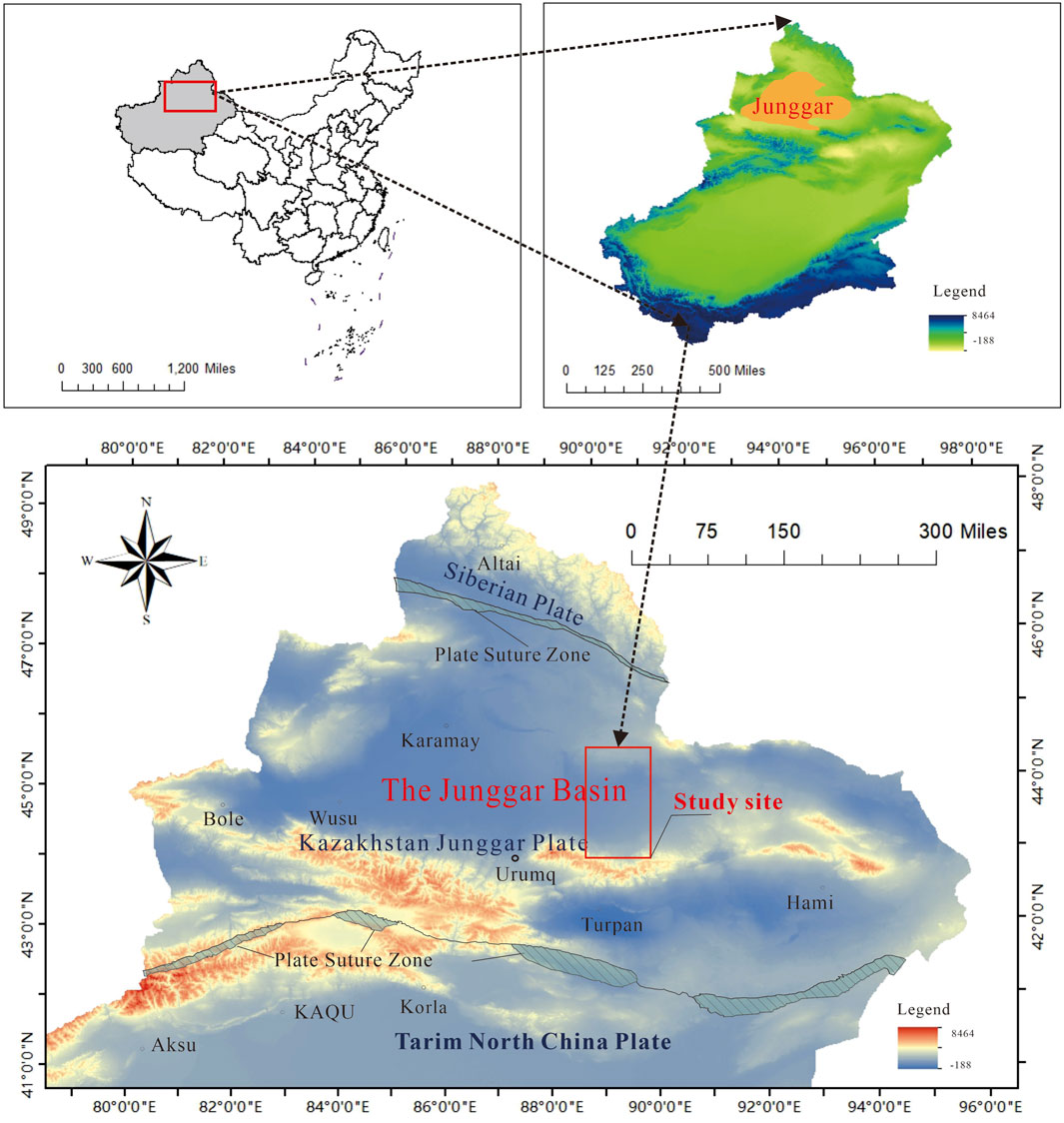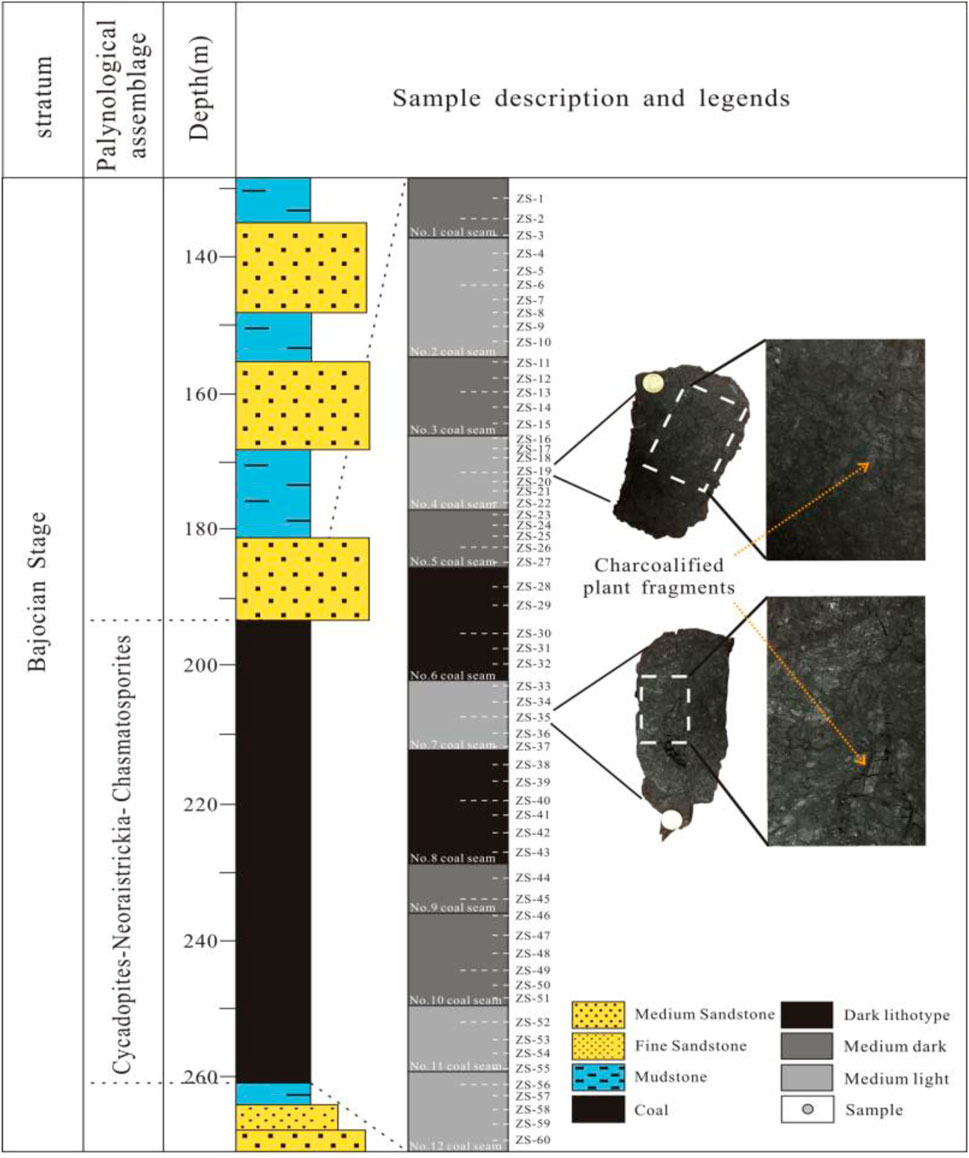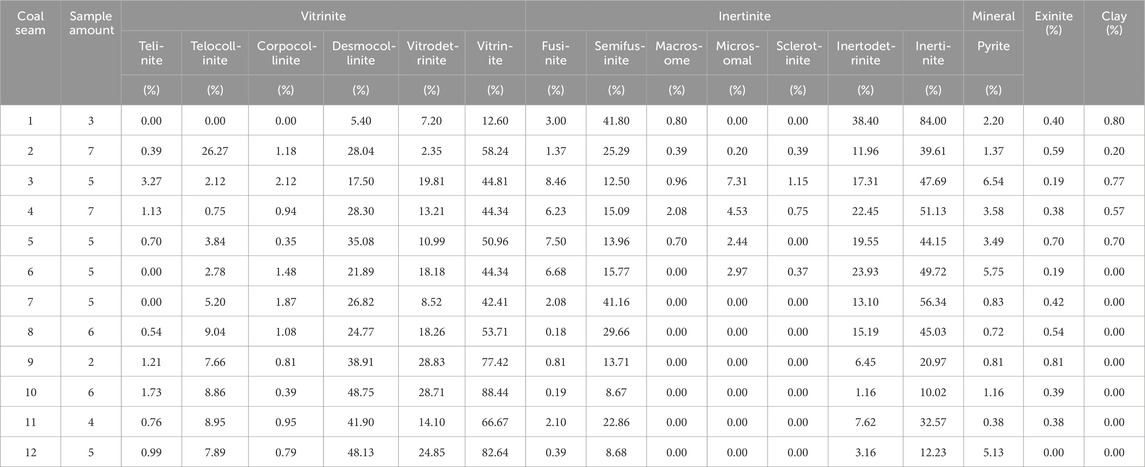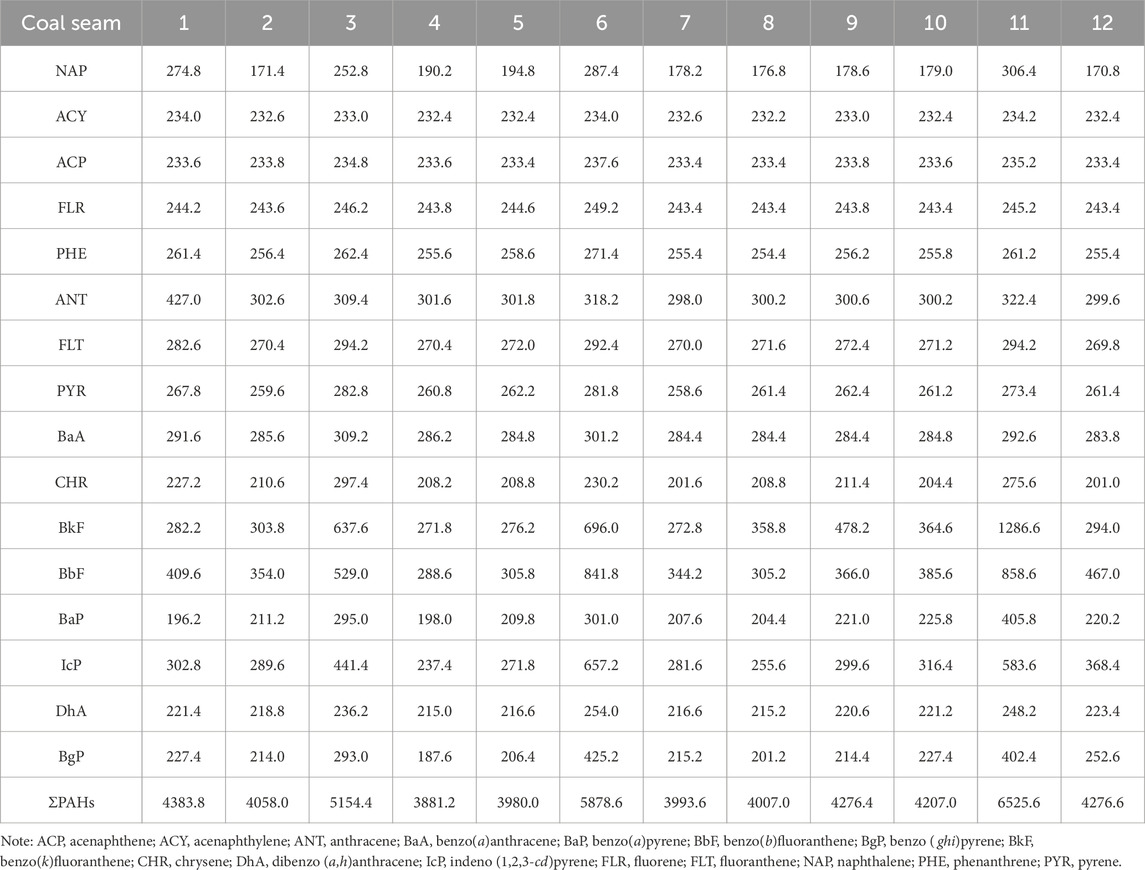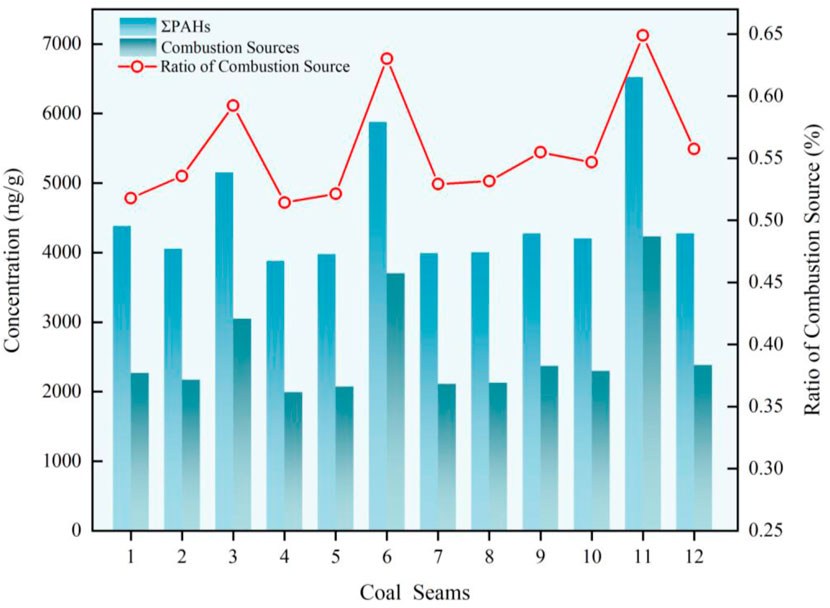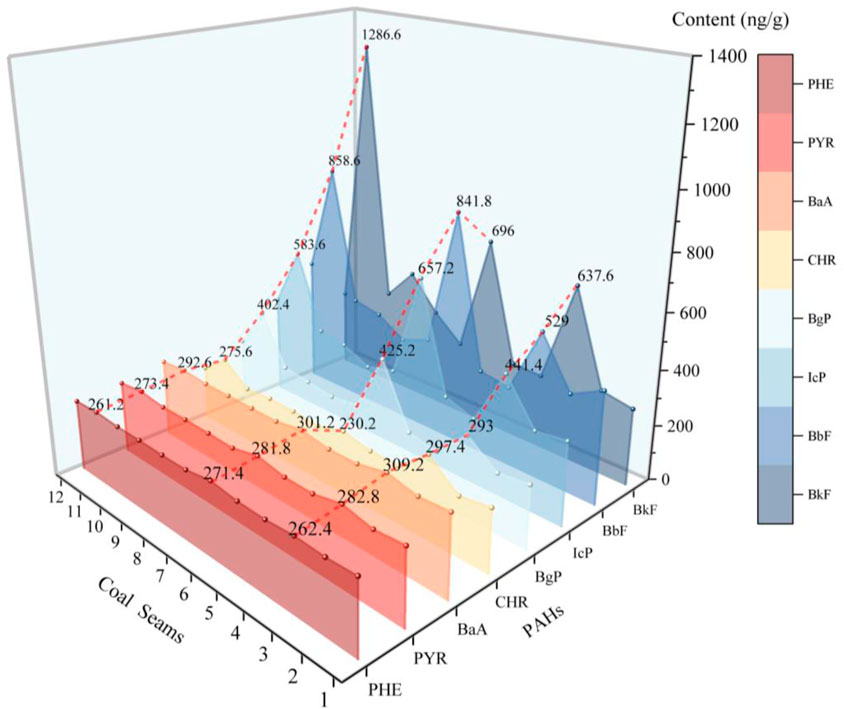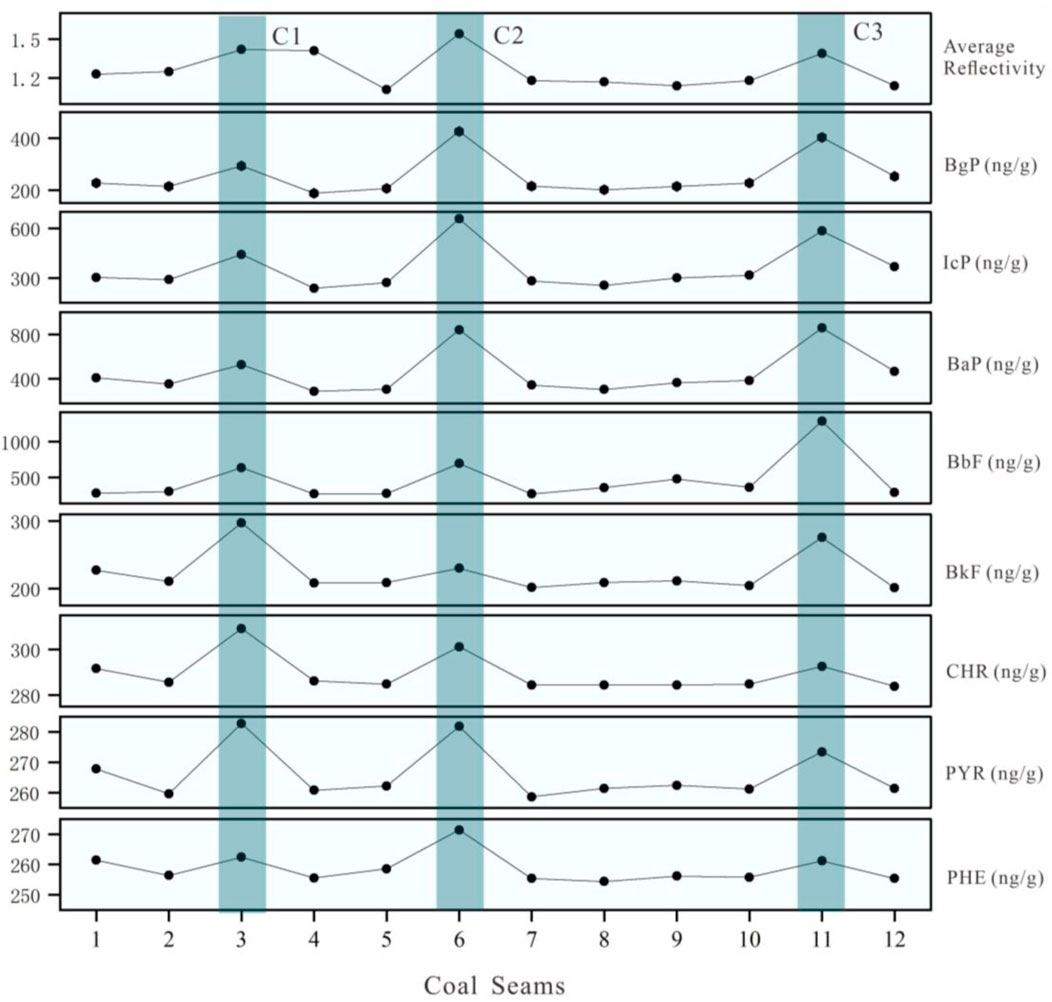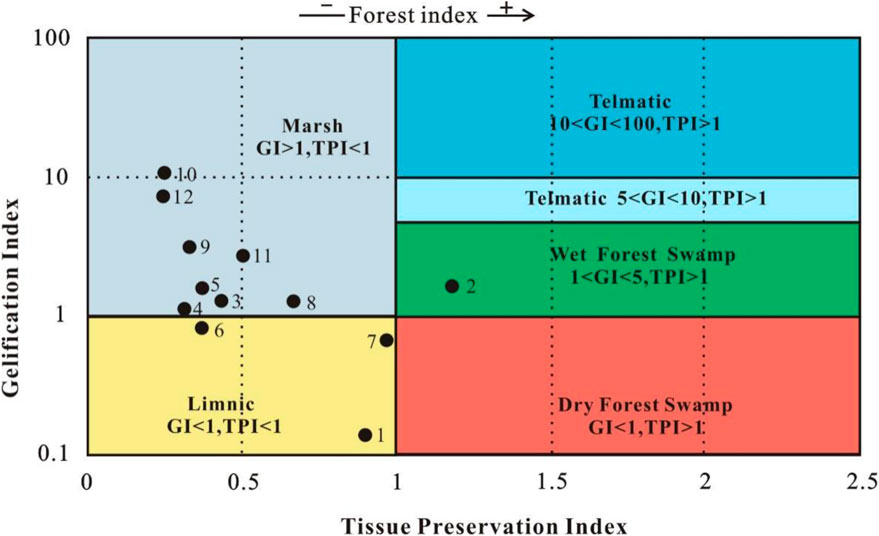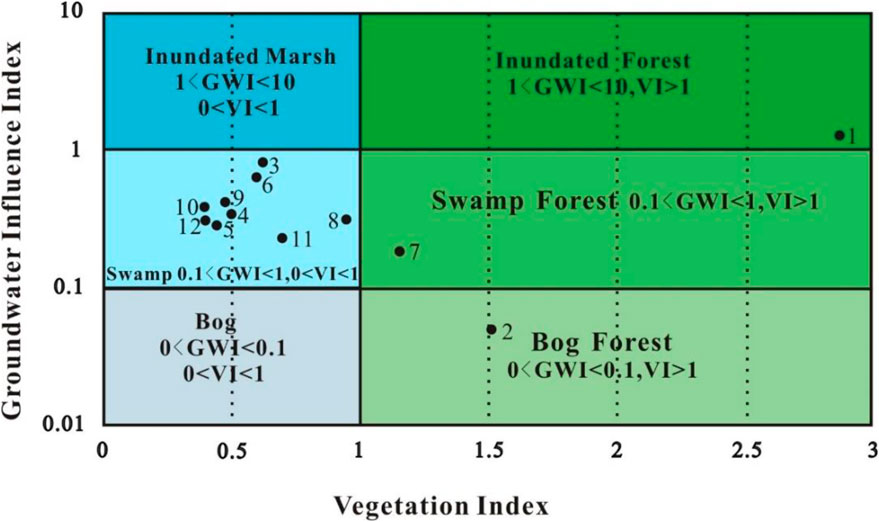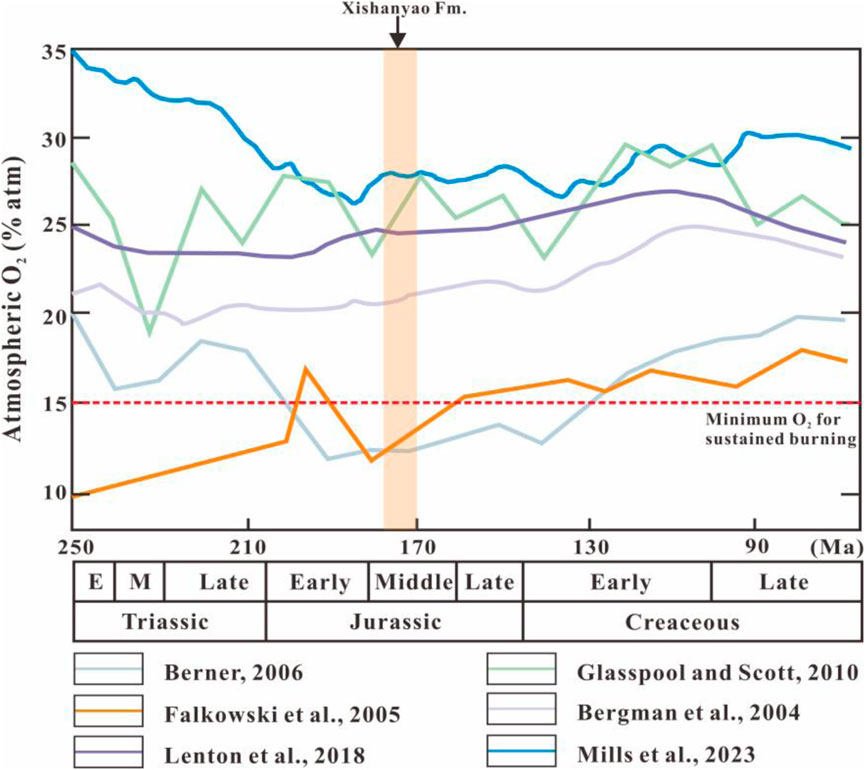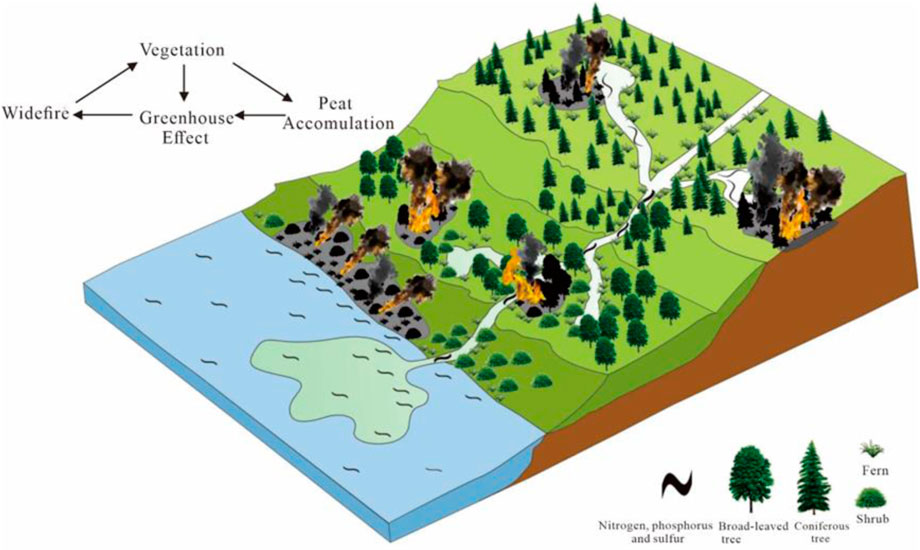- 1Xinjiang Key Laboratory for Geodynamic Processes and Metallogenic Prognosis of the Central Asian Orogenic Belt, Xinjiang University, Urumqi, China
- 2Exploration Division, PetroChina Xinjiang Oilfield Company, Karamay, China
- 3School of Resources and Geosciences, China University of Mining and Technology, Xuzhou, China
- 4School of Earth Resources, China University of Geosciences, Wuhan, China
Scholars increasingly support the hypothesis that inertinite in coal is the product of incomplete combustion of plants in coal-forming peat swamps during fire events. In this study, charcoal fragments were extracted from an extremely thick coal seam in the Wucaiwan mining area in the eastern Junggar Basin. The temperatures that caused palaeofires were then estimated using a reflective light microscope. The inertinite reflectance data (average 1.26%) indicated the formation of these charcoal fossils at temperatures of 300°C–400°C. Additionally, the content characteristics of 16 polycyclic aromatic hydrocarbons (PAHs) in the coal rock samples were determined by rapid solvent extraction by analyzing inertinite and reflectance data of samples from the Xishanyao Formation in the eastern Junggar Basin. The palaeofire events experienced by the coal seams during deposition were comprehensively analyzed. The PAH test results showed significant variation in PAH content between layers, ranging from 3,881 to 6,525 ng/g, with an average of 4,433 ng/g. Moreover, different PAHs within the same layer exhibited considerable variations in content. The integration of inertinite content, inertinite reflectance, and PAH characteristics led to the conclusion that the coal seam experienced at least three periods of frequent palaeofires during deposition. Combining these findings with charcoal reflectance data suggested that the palaeofires during these periods were predominantly low-to medium-temperature ground fires.
1 Introduction
Palaeofires refer to burning events that occurred prior to the Quaternary Period (Scott, 2000). These events have been widespread since the colonization of land by plants in the Devonian Period and have become an essential component of the Earth’s system. Charcoal is a highly inert and chemically stable product of incomplete biological combustion, well preserved in sedimentary strata. Microscopic charcoal generally indicates regional palaeofire events (Degani-Schmidt et al., 2015; Shukla et al., 2023; Seibert et al., 2024). In contrast, charcoal is not easily transported due to its greater mass and volume and is usually deposited at palaeofire sites or transported by running water in low-lying areas, which is usually indicative of localized palaeofire events (Zhang et al., 2014; Wang et al., 2019; Wang et al., 2021). Additionally, inertinite reflectance has been shown to be positively correlated with formation temperature. When inertinite reflectance exceeds 1%, the formation temperature is greater than 300°C—a threshold that cannot typically be reached by geothermal gradients alone. However, palaeofires in nature can easily reach these temperatures, with large-scale forest palaeofires sometimes exceeding 800°C (Lu, 2023; Xu et al., 2020; Cai et al., 2021; Wang et al., 2021; Xie et al., 2022; Xu et al., 2022; Han et al., 2024). Therefore, determining charcoal reflectance is crucial for distinguishing the occurrence and type of palaeofires.
Polycyclic aromatic hydrocarbons (PAHs) are widely present in environmental media such as soil, air, water, and animal and plant tissues, mainly in aerosol and solid forms; PAHs are not easily degraded or used by organisms due to their chemical stability (Marynowski and Simoneit, 2009; Schachat et al., 2018). Anomalously high concentrations of combustion-derived PAHs in Permian–Triassic boundary sediments have been considered the key evidence for globally frequent and significant palaeofire events in the Late Permian Period (Kaiho et al., 2021; Zhou et al., 2021; Jiao et al., 2024). Venkatesan and Dahl (1989) used PAHs as discriminating evidence when studying Cretaceous palaeofire events in the 1980s. Yunker et al. (2002) classified PAHs into three sources based on their molecular ratios: petroleum-derived, biomass combustion–derived, and fossil fuel combustion–derived. Song et al. (2020) divided PAHs into two categories. One has mainly a combustion origin, and the other has a noncombustion origin. PAHs of combustion origin mainly include phenanthrene (PHE), pyrene (PYR), chrysene (CHR), benzo(k)fluoranthene (BkF), benzo(b)fluoranthene (BbF), benzo(a)pyrene (BaP), indeno (1,2,3-cd)pyrene (IcP) and benzo (ghi)pyrene (BgP). The content of combustion-origin PAHs in the stratigraphy of the Permian–Triassic boundary in Meishan, Zhejiang, and the Triassic–Jurassic boundary in the Sichuan Basin was analyzed, revealing that a high frequency of palaeofires accompanied and facilitated these two biological extinctions. Kubik et al. (2020), also concluded that frequent palaeofire events occurred in the Early Permian Period in Parana Basin, Brazil, by studying anomalies in PAH content. These results indicated the feasibility of using PAHs as a discriminator for palaeofires.
The Junggar Basin deposits thick Jurassic terrestrial strata, and hence is ideal to investigate the paleoenvironmental and paleoclimatic evolution of the Jurassic landmass (Gao et al., 2020). Significant insights have been gained in the reconstruction of the Jurassic terrestrial palaeoenvironment and palaeoclimate in the Junggar Basin through the analyses of depositional environments, palaeobotany, sporology, elemental geochemistry, and organic carbon isotopes (Li et al., 2010; Tong et al., 2016). PAHs indicate palaeoclimate and palaeoenvironment, especially for palaeofire records. Middle Jurassic palaeofires occurred frequently, and PAHs from Middle Jurassic palaeofires have been recorded worldwide. However, reports on the Jurassic palaeofires in the Junggar Basin are few; information on palaeofires from the PAHs recorded in coals is also limited (Hossain et al., 2013; Kaiho et al., 2021; Vachula et al., 2022). Therefore, the present study considered the coal seams of the Middle Jurassic Xishanyao Formation in the Wucaiwan Mine in the eastern coal field of the Junggar Basin as the object. It investigated the distribution characteristics of the PAHs to extract the geologic information, providing strong evidence for the occurrence of the palaeofires in the Junggar Basin during the same period. It also provided a new perspective of molecular geochemistry for reconstructing the paleovegetation and paleoenvironment of the same period.
2 Geological background
The Junggar Basin is located in the northern region of Xinjiang, between the Altai Mountains and the Tian Shan Mountains (Li et al., 2023). The geotectonic position belongs to the southern part of the Central Asian orogenic belt, which is situated in the intersection area of the Siberian Plate, the Kazakhstan Plate, and the Tarim Plate (Figure 1). The west side of this basin is defined by the western mountainous area, and its east side reaches the foothills of the Beita Mountain. The basin exhibits an irregular triangular shape, with a terrain tilted to the west. As a result, the northern part is at a slightly higher elevation than the southern part. A series of syndepositional faults were developed by the intra-plate extrusion of the basin in the east–west direction, forming a series of NE or NS alternating convex and concave structures. This sag zone is beneficial to the development of the coal-bearing formation, although the salient area is unfavorable for the development of coal measures. As a result, the Junggar Basin is rich in coal and hydrocarbon resources.
The Eastern Junggar Coal Field is located on the northern margin of the eastern continental coal-bearing basin of Junggar, Xinjiang, and on the southern foothill of Kalamari Mountain (Huang et al., 2024). The Wucaiwan mining area is located in the northwest region of the Eastern Junggar Coal Field (Figure 1). The area neighbors the southern foothills of Kalamkari Mountain on the north and the Shazhang fold zone on the east. The coal-bearing stratum belongs to the upper Xishanyao Formation, Aalenian stage of the Middle Jurassic series, and has a coal-bearing seam thickness of 62 m. The stratum has a stable thickness and is widely distributed, possessing high-quality coal with low ash, low sulfur content, and high heat. The proven reserve of this stratum is substantial, and hence the seam has an extremely high commercial value.
3 Sampling and analytical methods
The data for this study were derived from the detailed petrographical, geochemical, and mineralogical analyses of 60 coal samples collected from the Eastern Junggar Coal Field. The samples from 12 coal seams were systematically collected based on the development characteristics and depth of Xishanyao Formation coal seams in the Wucaiwan mining area, Eastern Junggar Coal Field. Five samples were collected from each of the No. 3, No. 5, No. 6, No. 7, and No. 11 coal seams. Four samples were collected from each of the No. 9, No. 10, and No. 13 coal seams. Seven samples were collected from both the No. 2 and No. 4 coal seams. Six samples were collected from the No. 8 coal seam. Three samples were collected from the No. 1 coal seam. These 60 samples were numbered from beginning to end based on their original depths, such as the shallowest one numbered ZS-1 and the deepest one numbered ZS-60 (Figure 2).
Coal petrological analysis was primarily conducted via microscopic observation: Polished pellets were prepared according to ISO 7404–2 (2009), and examined using a Zeiss AxioScope A1 microscope equipped with ×10 ocular lenses and ×50 oil-immersion objectives. Fluorescence excitation in the violet range was applied during liptinite observation. Each polished pellet contained uniformly distributed measurement points (>500 counts). Vitrinite reflectance was determined using the identical microscope configuration coupled with a J&M MSP200 microspectrophotometer.
Soluble organic matter in coal was extracted via Soxhlet extraction, followed by group composition separation. Gas chromatography–mass spectrometry analysis of the aromatic hydrocarbon fractions can be used to determine their molecular composition and relative content. PAHs in coal were extracted and detected as previously described by Zakrzewski et al. (2020). The PAHs were extracted using a rapid solvent extraction device and then further purified using a Florisil solid-phase extraction column after nitrogen purging and concentration. The external standard solutions of 16 PAHs were diluted to the concentrations of 0.0, 0.1, 1.0, 2.0, 4, and 10 μg/mL with acetone–hexane mixture in the ratio of 1:1 by volume for generating calibration curves. The internal standard solution comprised five deuterated PAHs. Considering the high organic matter content and high density of the coal rock samples, the amount of sample should be reduced to 5 g during pretreatment, a 33-mL extraction tank should be used, and the size of coal rock particles should be controlled below 0.150 mm.
4 Results
4.1 Macroscopic coal characteristics
The extremely thick coal seams in the Junggar Basin of Xinjiang were primarily composed of semidull and dull coal lithotypes, exhibiting grayish-black to deep black coloration with massive and banded structures that displayed silky to bituminous luster (Figure 3B). Samples contained thin fusain layers characterized by silky luster and fibrous texture, appearing as charcoal-like fragments with grayish-black hue and soft, porous, friable properties (Figures 3A,C). Macroscopically, both physical characteristics and chemical features demonstrate striking similarities to wildfire-derived pyrogenic charcoal. Applying Scott (2010) macroscopic identification criteria for fossil charcoal, this study confirmed abundant charcoal occurrence within the Xishanyao Formation coal seams, manifesting as cubic blocks, bands, and elongated strips in the coal matrix.
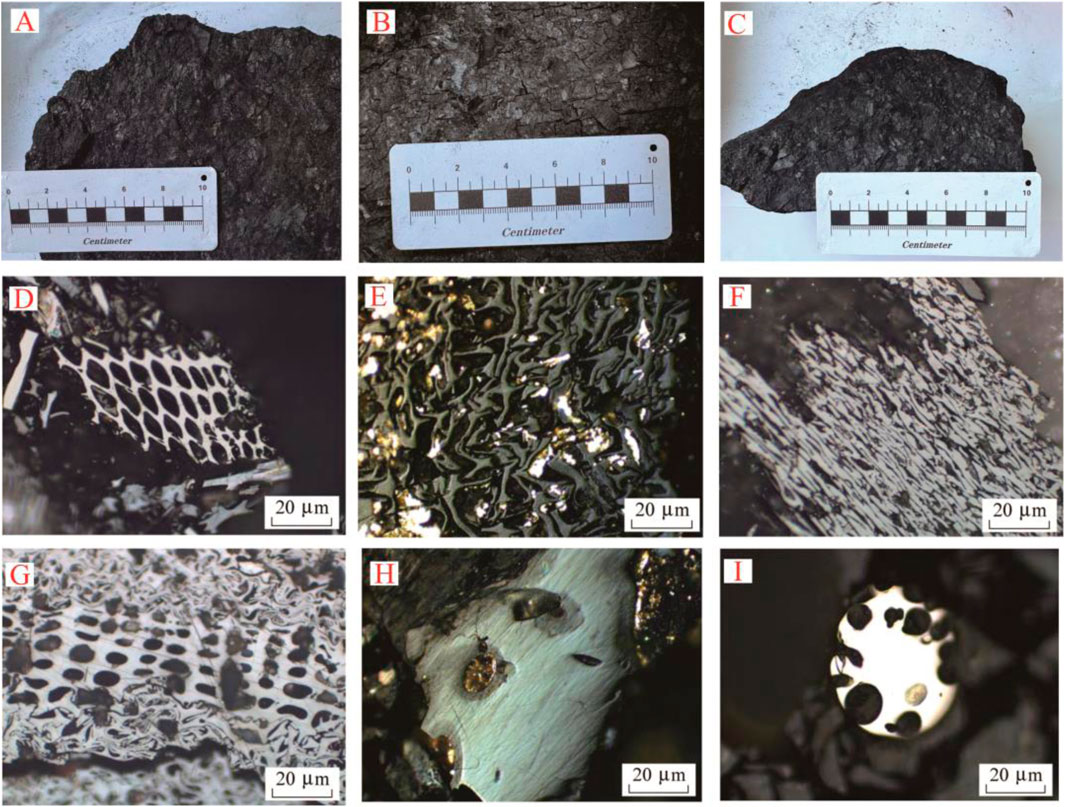
Figure 3. Fusain and Maceral Components in Coal. (A–C) Fusian (Charcoal) in the coal (D) Fusinite (f). (E) Semifusinite (sf) and pyrite (py). (F) Inertodetrinite (id). (G) Fusinite (f) and semifusinite (sf). (H) Macrosome (Ma). (I) Natural charcoal (nc).
4.2 Inertinite in coal
The qualitative observations and quantitative analysis of the macerals obtained from the coal of interest indicated that the maceral sample in this study was dominated by vitrinite and inertinite, with a tiny proportion of exinite (Table 1). In particular, the vitrinite content was 12.65%–82.64% (averaged at 55.78%), and the inertinite content was 12.23%–84.34% (averaged at 41.29%). The vitrinite in various layers was dominated by desmocollinite and vitrodetrinite, with a small amount of telocollinite. The inertinite was dominated by semi-fusinite and inertodetrinite, with few microsomes. Clay was rarely developed, and the mineral fraction was mainly dominated by pyrite with an average content of 2.67%.
The main targets for reflectance measurements of inertinite were microscopic forms of charcoal, that is, filamentous, semi-filamentous, and inertodetrinite (Figure 3). The characterization and extent of palaeofire events in coal seams were revealed by determining the reflectance of these microscopic components. The results of the reflectance measurements of the inertinite showed significant differences in reflectance among the samples. Especially the maximum reflectance ranged from 1.86% to 3.17%, indicating that the degree of heat exposure of different coal seams during palaeofires varied significantly. However, the differences between the average and minimum reflectance values of the samples were within 0.5%, indicating that these coal seams had a more consistent reflectance profile overall. In addition, the standard deviations ranged from 0.29 to 0.54, further illustrating the relative stability and consistency of the reflectance data.
4.3 Coal facies analysis
The maceral content of a coal seam is a key indicator of its genesis and serves as a crucial criterion for classifying coal facies. We adopted the genetic parameter method involving a quantitative analysis of maceral evidence for classifying coal facies types, in part because it is the most popular method for coal facies analysis at present.
The coal-forming swamp was analyzed using tissue preservation index (TPI), gelification index (GI) (Diessel, 1982; Diessel, 2012), groundwater influence index (GWI), vegetation index (VI) (Calder et al., 1991), and T-D-F triangular diagram. In addition, the vitrinite/inertinite (V/I) ratio, woodland index, framework/matrix (F/M) ratio, oxidation index (Gorbanenko and Ligouis, 2015), transfer index, breaking index, and mobility index were adopted to analyze the coal-forming swamp with palynological assemblage characteristics in the research area (O’Keefe et al., 2013). The latter parameters reflected the vegetational forms of the coal-forming swamp, the changes in the swamp water coverage depth, and the strength of the hydrodynamic force in the research area so that the conclusion was more accurate and reliable (Sen et al., 2016; Silva et al., 2008; DiMichele et al., 2017).
Based on the statistical calculations, the variations in each coal facies parameter in the study area were characterized as follows: the TPI ranged from 0.23 to 1.21, with a mean value of 0.55; the GI ranged from 0.16 to 8.83, with a mean value of 2.45; the GWI ranged from 0.07 to 1.48, with a mean value of 0.57, and the overall GWI was on the lower side. In addition, the VI ranged from 0.24 to 3.22, and the V/I ratio ranged from 0.15 to 8.83, with a mean value of 2.4.
4.4 Determination of PAHs
The 16 PAHs in the 60 samples extracted were naphthalene (NAP), acenaphthylene (ACY), acenaphthene (ACP), fluorene (FLR), phenanthrene (PHE), anthracene (ANT), fluoranthene (FLT), PYR, benzo(a)anthracene (BaA), chrysene (CHR), benzo(k)fluoranthene (BkF), benzo(b)fluoranthene (BbF), benzo(a)pyrene (BaP), indeno (1,2,3-cd)pyrene (IcP), dibenzo (a,h)anthracene (DhA), and benzo (ghi)pyrene (BgP). The range of variation in ΣPAHs among different samples in the study area was relatively large (Table 2), ranging from 3,881 to 6,525 ng/g, with a mean value of 4,433 ng/g. The contents of different types of PAHs in the same sample varied significantly. Classified by the number of PAH rings, two-ring aromatic hydrocarbons accounted for 4.51%, three-ring aromatic hydrocarbons accounted for 28.69%, four-ring aromatic hydrocarbons accounted for 23.57%, five-ring aromatic hydrocarbons accounted for 24.83%, and six-ring aromatic hydrocarbons accounted for 18.41%.
5 Discussion
5.1 Evidence of palaeofires
5.1.1 Evidence from coal petrology experiment
Coal petrology was first used to describe inertinite macerals. Hence, whether all inertinites were of fire origin was under continuous discussion. Xu et al. (2020) determined palaeofire types and their climatic impacts in the Jurassic Ordos Basin through inertinite content and reflectance analysis of coals, while Wang et al. (2019) employed similar methodology to analyze paleowildfire extent, types, and intensity in Early Cretaceous Northeast China, concurrently inferring contemporary paleoclimatic conditions. Falcon (1989), Hunt (1989), and Taylor et al. (1998) suggested that the high-frequency distribution of inertinite composition in coal was not due to the thermal action of combustion. Based on available evidence, Scott (1989), Scott (2000), Scott (2002), Scott (2010), Scott and Glasspool (2007), and Hudspith et al. (2012) showed that almost all inertinite macerals with high reflectance were charcoal, namely, charcoal fossils formed by burning ancient plants.
Inertinite analysis revealed contents ranging from 12.23% to 84.34% (mean: 41.29%) in the samples. The most prevalent inertinite macerals identified during this investigation were fusinite, semifusinite, and inertodetrinite, with extensively distributed fusain components (Figure 3). Key characteristics include: (1) Fusinite displaying well-preserved cellular structures, partially degraded plant tissues, and elevated reflectance, indicating thermal alteration of vegetation (Figures 3A–C); (2) Semifusinite occurring as banded or fragmented particles with moderately high reflectance and partially preserved lignocellulosic structures, frequently associated with cubic or spheroidal pyrite aggregates exhibiting bright metallic luster (Figures 3D,F); (3) Angular black fragments demonstrating high reflectance, anisotropic optical properties, and disordered cellular remnants (Figure 3E); (4) Abundant natural charcoal exhibiting densely distributed, irregularly shaped vesicles (Figures 3G–I). Contemporary research confirms that fusinite and semifusinite in coal originate from wildfire-induced thermal alteration of organic matter, displaying significantly higher reflectance than vitrinite in low-rank coals. Consequently, this study interprets these macerals as charcoal and proposes inertinite as a paleowildfire indicator. While not excluding possible pre-oxidation scenarios, we classify oxidized-then-combusted fusinite as pyrogenic in origin. The Middle Jurassic peat deposits along the eastern Junggar Basin margin recorded extensive regional forest fires.
5.1.2 Evidence for PAHs
Shen et al. (2011) provided high-resolution records of palaeofire events through analysis of PAH molecular composition and concentration fluctuations, combined with indicators such as black charcoal reflectance and mercury anomalies. The spatiotemporal coupling of these events with volcanic activity, climatic aridification, and ecosystem collapse revealed wildfire’s multifaceted role in environmental crises during the Permian-Triassic transition, offering molecular geochemical evidence for understanding mass extinction mechanisms. Similarly, Zhang (2020) demonstrated through analysis of high-molecular-weight polycyclic aromatic hydrocarbons (PAHs) in Yan’an Formation coal seams of the Ordos Basin that macromolecular PAHs can indicate peat wildfire events. Consistently elevated inertinite content and pyrolytic PAH concentrations throughout the studied coal seams collectively indicate widespread peatland wildfires during the Aalenian stage of the Middle Jurassic in the Ordos Basin.
Thermal events, biodegradation, and weathering can lead to the degradation of PAHs. Hence, we should exclude these three factors while using PAHs as the indicators of palaeofire events (Scott, 2009; Wang and Liu, 2015; Zhan et al., 2011). The amount of a particular PAH should be relatively stable among samples under the same geologic conditions. However, the occurrence of palaeofires can alter this stabilizing trend by generating some specific types of PAHs. In this study, we referred to the classification scheme for PAHs proposed by Song et al. (2020), and categorized the 16 PAHs into combustion and noncombustion origin. PAHs of combustion origin included PHE, PYR, CHR, BkF, BbF, BaP, IcP, and BgP. The amount of combustion-induced PAHs was low in most sediments. However, when the PAH content suddenly increased in a certain stratum, it indicated that a palaeofire event occurred during the sedimentary period.
The variations in the amount of combustion-induced PAHs in the samples in the study area ranged from 49.7% to 66.6%, except for No. 3, No. 6, and No.11 coal seams with a significantly higher amount of combustion-induced PAHs (more than 58.5%). The amount of combustion-induced PAHs in the remaining samples was less than 54.9%. Eight combustion-related PAHs were significantly enriched in the No. 3, No. 6, and No.11 coal seams (Figures 4, 5). We concluded that the No. 3, No. 6, and No. 11 coal seams experienced a high frequency of palaeofire events during deposition. We substituted the experimental data into the model of Yunker et al. (2002) to identify the source of PAHs. It was concluded that the main source of PAHs in all samples was organic biomass combustion, indicating good overall uniformity. Although the model showed that the source of PAHs in all the samples was biomass combustion, they were all on the boundary between fossil fuel combustion and biomass combustion, with no clear-cut boundary with fossil fuel combustion. This was consistent with the finding of FL/PYR ratio that both were pyrolytic in origin.
Peat swamps are capable of developing palaeofires. Plants in the peat swamps burn to form charcoal, which is then deposited into the swamps. Combining the evidence from coal lithology and PAHs, it was clear that high-frequency palaeofires occurred in the peat bogs during the deposition of the No. 3, No. 6, and No. 11 coal seams in at least three periods.
On the one hand, the amounts of both total PAHs and the eight common PAHs considered as the cause of combustion were significantly higher in the aforementioned three samples than in the other samples (Figures 4–6). On the other hand, biomass combustion was the most dominant source of PAHs in the coal. Finally, the inertinite reflectance of the No. 3, No. 6, and No. 11 coal seams showed a significant increase, with a high degree of agreement between them compared with the PAH data (Figure 6). High inertinite contents were more indicative of high-frequency and in situ–semi-in situ combustion (Figure 6). A comparison of PAH data revealed a high degree of agreement between the two (Figure 6). Overall, the available research findings indicated that high-frequency palaeofire events occurred in the peat swamps of the study area during the deposition of No. 3, No. 6, and No. 11 coal seams.
5.2 Characteristics of coal facies
The results of quantitative calculations and comprehensive analyses of the model parameters showed that the TPI values of the samples were generally less than 1, except for the No. 2 coal seam (Figure 7). This result suggested that herbaceous plants were the main coal-forming plants and the depositional environment was mainly a low peat swamp. The microscopic composition of coal seams deposited in this environment is characterized by a more fragmented cellular structure. In addition, the magnitude of TPI also indicated the pH of water. The bacterial activity is weaker and does not decompose plant remains as strongly in low-pH water environments; in contrast, decomposition is more intense at higher pH levels. Therefore, the TPI of the coal samples in the study area indicated that the water environment during coal formation was acidic and the plant cellular structure was not well preserved. The GI of the samples was generally greater than 1 and less than 5, suggesting that the coal-forming swamps were relatively humid and occluded. However, gelatinization was not pronounced and some of the vitrinite still retained cellular structure.
The analysis revealed that the GWI of all samples, except No. 1 and No. 3 coal seams, was less than 0.5 (Figure 8). This indicated that the hydrodynamic intensity was weak. The influence of groundwater on the coal-forming swamps was small, providing favorable conditions for the stable and continuous development of the coal-forming swamps. Conversely, the higher hydrodynamic intensity of the depositional period in the No. 1 and No. 3 coal seams resulted in the destruction of plant remains. Overall, groundwater is not a major factor influencing coal phase changes. Most of the coal seams in the study area were distributed in wetland swamp facies where herbaceous plants were the primary source of their coal formation. However, the No. 1, No. 2, and No. 7 coal seams belonged to the forest facies whose coal-forming plants were mainly woody plants. The bottom–up approach revealed the transitional characteristics of the depositional environment from the wetland swamp facies to the overlying water forest facies. The genesis of the coal seams in the study area was primarily associated with herbaceous plants. However, woody plants were also crucial in specific depositional environments, and groundwater was not a dominant factor.
5.3 Types of palaeofires
The reflectance of charcoal increases with the increase in carbonization temperature (Liu et al., 2022). The reflectance of charcoal from modern palaeofires is related to the type of combustion and temperature at which the plant is burned, with reflectance ranging from 0% to 7.6%. Scott and Glasspool. (2007) determined the reflectance of charcoal formed at different combustion times and temperatures. As shown in Figure 9, when the combustion temperature was higher than 300°C, the charcoal reflectance gradually increased with the increase in time to stabilize; at the same combustion time, the charcoal reflectance increased with the increase in combustion temperature. Despite no perfectly linear relationship between the reflectance of inertinite and the burning temperature, the burning temperature of a forest palaeofire could be calculated using the following linear regression equation (Jones, 1997):
where T is the combustion temperature, Ro is the reflectance of inertinite, and r2 is the coefficient of determination.
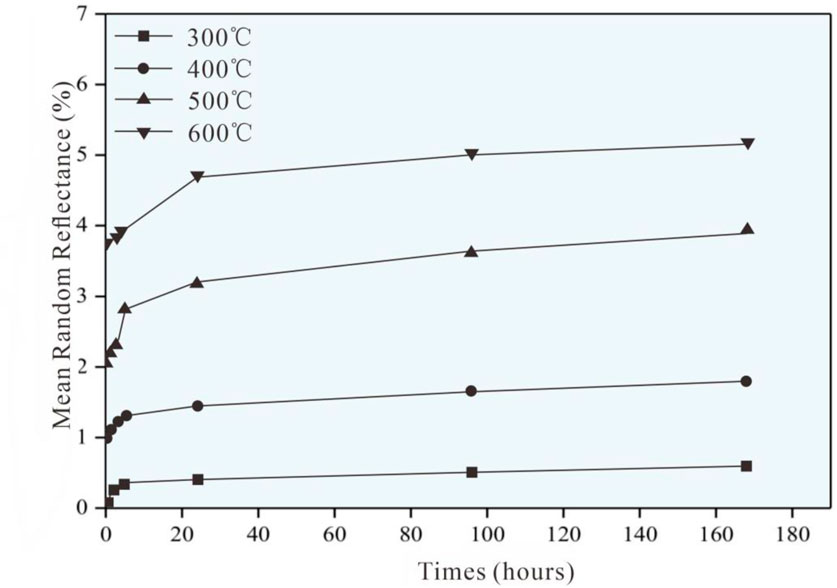
Figure 9. Change in mean random reflectance with time of the experimental charcoal formation from Sequoia sempervirens wood (Scott and Glasspool, 2007).
Based on the combustion of pines and mangroves, Ascough et al. (2010) developed a plot of charcoal reflectance versus formation temperature, revealing a linear relationship between these factors. Their findings were used to project the average and maximum reflectance values of the charcoal tested in this study (Figure 10). Based on the calculation using Formula 1, The maximum temperature for the formation of charcoal was 350°C in the No. 3 coal seam (samples from ZS-11 to ZS-15) of the Eastern Junggar Coal Field, 364°C in the No. 6 coal seam (samples from ZS-28 to ZS-32), and 347°C in the No. 11 coal seam (samples from ZS-52 to ZS-55). Scott (2000) demonstrated that plant cell walls undergo homogenization at charring temperatures exceeding 300°C–325°C. Observations of inertinite in key coal seams within the study area (Figures 3D,G) revealed significant homogenization of fusinite cell walls, directly indicating that widespread Middle Jurassic forest wildfires in the eastern Junggar Basin exceeded 300°C.
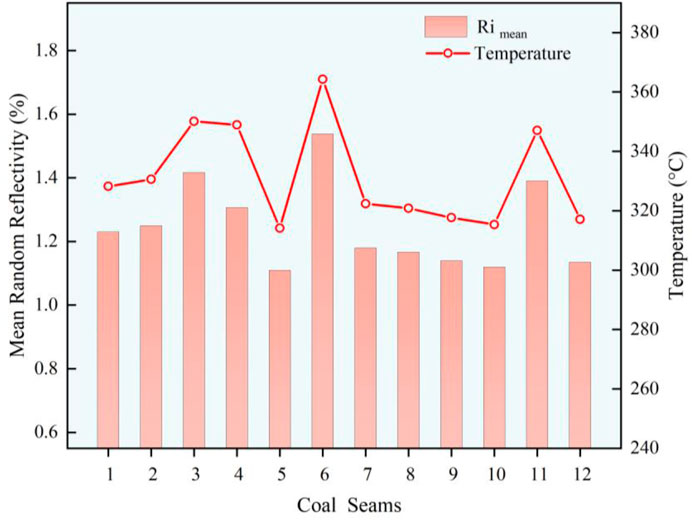
Figure 10. The Rimean in each coal seam and its corresponding forming temperature. Modified from Ascough et al. (2010).
Using reflectance to determine the type of palaeofires is not the most accurate method because, irrespective of the intensity of palaeofires, areas of inadequate combustion and low temperature are always observed during palaeofires. These areas do not accurately represent the overall reflectance of the location, making the method less reliable. Hence, the data should be carefully processed when assessing palaeofire types, especially when distinguishing between surface and crown fires. However, how to process and correct the data when using the inertinite reflectance to distinguish the types of palaeofires remains unclear. Also, a large number of indoor experiments and data analyses should be conducted to solve this problem. Given the current lack of mature processing solutions, this study still adopts the mainstream method used in the field, performing fire type analysis through mean inertinite reflectance. We simultaneously acknowledge that this method requires refinement through integration with multiple indicators. As shown in Figure 10, the combination of relatively high inertinite content in coal seam samples from the study area and combustion-derived polycyclic aromatic hydrocarbons suggests that palaeofire temperatures during peat deposition in the eastern Junggar Basin’s Xishanyao Formation were concentrated between 300°C and 400°C. This further suggests that the dominant palaeofire types were low-to-medium temperature ground fires.
5.4 Relationship between jurassic palaeofires and palaeoclimate
5.4.1 Palaeofires indicative of atmospheric oxygen levels
Fire, fuel, and oxygen are necessary for the occurrence of palaeofires. Belcher and McElwain (2008) indicated that vegetation with high water content required a minimum oxygen content of 15% to sustain combustion. Jasper et al. (2013) concluded that wood with a moisture content greater than 12% required no less than 16% oxygen to burn, whereas wood with a moisture content less than 2% required 12% oxygen to burn. Many scholars have modeled the oxygen content of the atmospheric groups during various geologic periods of the Mesozoic Era (Figure 11). As shown in the figure, the predictions of Berner (2006) and Falkowski et al. (2005) for the atmospheric oxygen content in the Jurassic Period were relatively low, with the oxygen content of about 12%–15% and 12%–17%, respectively. The oxygen content in the Middle Jurassic Period, was around the lowest point of 12%, but such a low oxygen content could not sustain the burning of vegetation. Bergman et al. (2004) showed that the atmospheric oxygen content ranged from about 20% to 22% in the Jurassic Period and 21% in the Middle Jurassic Period. Glasspool and Scott (2010) suggested that the atmosphere in the Jurassic Period was oxidized by a relatively high amount of oxygen, ranging from 23.5% to 28%.
Glasspool and Scott (2010) constructed a curve of atmospheric oxygen content spanning 400 million years based on the proportion of inertinite in coal. Glasspool et al. (2015). Subsequently refined the prediction model based on this study. The inertinite and oxygen content data in coal were fitted as shown in the following equation:
where I is the inertinite content, o is the atmospheric oxygen content, omin is the atmospheric oxygen content when the inertinite content is 0, omax is the atmospheric oxygen content when the inertinite content is 100%, and n controls the maximum steepness of the curve. The average inertinite content of all coal samples in the Xishanyao Formation was 42.1%. The Formula 2 shows that the atmospheric oxygen content during the depositional period of the Xishanyao Formation was as high as 27.1% (Figure 12). This result coincided with the oxygen content of the period (28.3%) derived by the creator of the model.
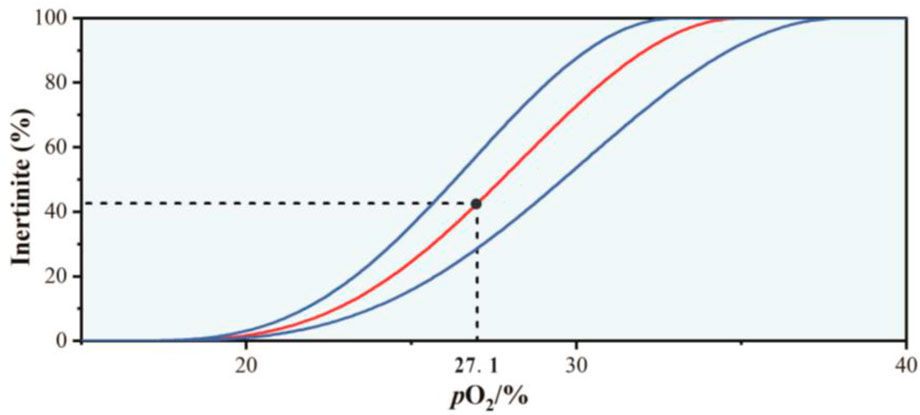
Figure 12. Calibration curve of inertinite content versus O2 content (Glasspool et al., 2015).
Diessel and Gammidge (1998), Diessel (2010), and Hamad et al. (2012) detailed the global palaeofire events that occurred at the turn of the Jurassic and Cretaceous periods. The findings might help in understanding the variations in atmospheric oxygen content (PO2) during palaeofires. The Junggar landmass resided in a warm and humid subtropical climate for a long time during the Aalenian stage of the Mesozoic Middle Jurassic series. This led to the development of numerous large lakes with vast areas of vegetation growing on the rims of the lakes throughout the basin, thus providing a large amount of fuel for such a wildfire event (Scotese et al., 2021). The phytocommunity of the Aalenian stage was rich in lignin and hence might have provided a low fire initiation point and a high ignition rate for activation (ignition). Therefore, the basin had a higher chance of burning under those conditions than in a modern fire (Hollaar et al., 2024).
5.4.2 Palaeofire-climate feedback mechanisms and carbon cycle implications
Palaeofires are influenced by a combination of factors such as vegetation, atmospheric oxygen levels, and wet and dry climates, besides the regional and global climate. Palaeofires produce large quantities of greenhouse gases that effectively prevent surface heat from escaping, thus exacerbating the greenhouse effect. An increase in the greenhouse effect raises average global temperatures, leading to higher surface evaporation and making surface vegetation somewhat drier and thus more susceptible to ignition. Additionally, the increased greenhouse effect promotes vegetation growth, with large amounts of carbon dioxide accelerating vegetation growth through photosynthesis and large-scale vegetation providing more fuel for palaeofires. Extensive growth of vegetation produces large amounts of oxygen, increasing atmospheric oxygen levels and reducing the likelihood of palaeofires. Moreover, palaeofires release large amounts of charcoal fragments, plant tissues, and elements such as carbon, phosphorus, and sulfur into rivers, lakes, and oceans through the water cycle, driving primary productivity in these areas and further increasing atmospheric oxygen levels. Hydrophobic hydrocarbons produced during combustion condense on topsoil aggregates, forming a water-repellent interface subject to downward leaching and deposition under rainfall, thus increasing rainy-season surface runoff from forested areas (Arcenegui et al., 2008; DeBano, 2000). The loss of the leaf litter r enhances the impact of rainfall on the soil and increases surface soil erosion (Marcos et al., 2000). Eroded soils carry large amounts of organic matter into water bodies, promoting primary productivity within the aquatic environment (Figure 13).
Available data suggests a net cooling effect of peat accumulation on global climate during the Holocene Epoch. Since the Jurassic Period, like the Holocene Epoch, is a globally significant coal-forming period, we suggest that this cooling event is, in some way, related to the massive deposition of peat (Frolking and Roulet, 2007; Frolking et al., 2011). Palaeofires in peat deposition areas can disturb carbon stocks, leading to soil carbon loss (Salimi et al., 2021) while slowing down the removal of greenhouse gases. However, further research is needed to determine whether the deposited peat can ignite under the influence of palaeofires or other factors (atmospheric oxygen content, temperature, and heating time). If so, peatlands could become a major source of atmospheric CO2, significantly affecting the global carbon cycle.
5.4.3 Response of regional paleoclimate characteristics to global climate change events
During the Early Jurassic, the supercontinent Pangaea began fragmenting into Laurasia in the north and Gondwana in the south, with the gradual formation of the Atlantic Ocean. This continental fragmentation led to extended coastlines and the inundation of low-latitude regions by shallow seas, which increased the ocean’s moderating influence on climate and rendered many inland areas more humid. Compounded by extensive volcanic activity releasing vast amounts of carbon dioxide, the greenhouse effect intensified. This combination established the Jurassic as a period characterized by a typical greenhouse climate state in Earth’s history, featuring a warm, humid global background alongside regional aridity (Dera et al., 2009; Brigaud et al., 2009; Sellwood and Valdes, 2000). Although the Jurassic overall existed within a greenhouse climate state, it experienced multiple significant temperature fluctuations. On shorter timescales, particularly during the early Toarcian, several transient magmatic events occurring within the Jurassic injected large volumes of CO2 into the atmosphere. This caused a pronounced perturbation of the carbon cycle that persisted for an extended period, ultimately leading to a hyperthermal event during the Toarcian (Dera et al., 2011). δ18O and δ13C data indicate that the fluctuating temperature recovery during the Aalenian induced seasonal aridity (Dera et al., 2011), which promoted frequent regional low-to-medium temperature surface fires. These fires acted synergistically with greenhouse gases released by the waning indirect volcanic activity of the Karoo-Ferrar Large Igneous Province and the North Sea Event, thereby exacerbating both the magnitude and frequency of climatic warming. Charcoal fragments generated by wildfires were transported by rivers to peat swamps during humid periods, forming the distinctive high-inertinite layers within the exceptionally thick coal seams of the eastern Junggar Basin coalfield. This process reveals a chain-response mechanism linking Aalenian climatic oscillations (warming → drought → wildfire → charcoal deposition) to coal formation, demonstrating that the climate-ecosystem response mechanism in the eastern Junggar Basin represents an exemplary feedback to global carbon cycle perturbations and warming events.
6 Conclusion
(1) Combining evidence from coal petrology and PAHs, it was found that a high frequency of palaeofires occurred in the coal seam during at least three periods, that is, the depositional periods of No. 3, No. 6, and No. 11 coal seams. The formation temperatures of the samples corresponding to the reflectance were 350°C, 364°C, and 347°C, indicating that the deposition of these three coal seams was dominated by low-to medium-temperature ground fires.
(2) The evidence from this study suggested that charcoal was less associated with seasonal drought during deposition and therefore could not be used to determine the transition to an arid climate. Many continental palaeoenvironments were moist, and humidity had little effect on the ignition performance of fuel loads. Even wet plants could burn in the eastern Junggar Basin during the Aalenian stage. The reconstruction of atmospheric oxygen content during the early Middle Jurassic depositional period, based on the inertinite content of the coals, suggested that the atmospheric oxygen content at that time was as high as 27.1%.
(3) The impact of wildfires on climate varied under different conditions. The destruction of vegetation by wildfires and the release of greenhouse gases slowed down the weakening of the greenhouse effect.
Data availability statement
The raw data supporting the conclusions of this article will be made available by the authors, without undue reservation.
Author contributions
QZ: Conceptualization, Data curation, Investigation, Methodology, Software, Writing – original draft, Writing – review and editing. SF: Conceptualization, Formal Analysis, Funding acquisition, Methodology, Supervision, Writing – review and editing. BY: Data curation, Formal Analysis, Methodology, Writing – review and editing. XL: Conceptualization, Data curation, Formal Analysis, Methodology, Writing – review and editing. WW: Conceptualization, Formal Analysis, Funding acquisition, Methodology, Resources, Writing – review and editing. JT: Conceptualization, Data curation, Formal Analysis, Methodology, Writing – review and editing. XW: Investigation, Methodology, Software, Writing – review and editing.
Funding
The author(s) declare that financial support was received for the research and/or publication of this article. This work was financially supported by the National Natural Science Foundation of China (Grant No. 42162017), Autonomous Region Major Science and Technology Special Program (Grant No. 2022A03015), the Science and Technology Program of Xinjiang Uygur Autonomous Region (2023D04056), the Major Scientific and Technological Project in the Xinjiang Uygur Autonomous Region (2022A03014) and the Tianshan Talent Program (Natural Sciences) - Science Talent Program (Grant No. 2023TSYCCX0009).
Conflict of interest
Author BY was employed by PetroChina Xinjiang Oilfield Company.
The remaining authors declare that the research was conducted in the absence of any commercial or financial relationships that could be construed as a potential conflict of interest.
Generative AI statement
The author(s) declare that no Generative AI was used in the creation of this manuscript.
Publisher’s note
All claims expressed in this article are solely those of the authors and do not necessarily represent those of their affiliated organizations, or those of the publisher, the editors and the reviewers. Any product that may be evaluated in this article, or claim that may be made by its manufacturer, is not guaranteed or endorsed by the publisher.
References
Arcenegui, V., Mataix-Solera, J., Guerrero, C., Zornoza, R., Mataix-Beneyto, J., and García-Orenes, F. (2008). Immediate effects of wildfires on water repellency and aggregate stability in Mediterranean calcareous soils. Catena 74 (3), 219–226. doi:10.1016/j.catena.2007.12.008
Ascough, P. L., Bird, M. I., Scott, A. C., Collinson, M. E., Cohen-Ofri, I., Snape, C. E., et al. (2010). Charcoal reflectance measurements: implications for structural characterization and assessment of diagenetic alteration. J. Archaeol. Sci. 37 (7), 1590–1599. doi:10.1016/j.jas.2010.01.020
Belcher, C. M., and McElwain, J. C. (2008). Limits for combustion in low O2 redefine paleoatmospheric predictions for the Mesozoic. Science 321 (5893), 1197–1200. doi:10.1126/science.1160978
Bergman, N. M., Lenton, T. M., and Watson, A. J. (2004). COPSE: a new model of biogeochemical cycling over Phanerozoic time. Am. J. Sci. 304 (5), 397–437. doi:10.2475/ajs.304.5.397
Berner, R. A. (2006). GEOCARBSULF: a combined model for Phanerozoic atmospheric O2 and CO2. Geochimica Cosmochimica Acta 70 (23), 5653–5664. doi:10.1016/j.gca.2005.11.032
Brigaud, B., Durlet, C., Deconinck, J. F., Vincent, B., Pucéat, E., Thierry, J., et al. (2009). Facies and climate/environmental changes recorded on a carbonate ramp: a sedimentological and geochemical approach on Middle Jurassic carbonates (Paris Basin, France). Sediment. Geol. 222 (3-4), 181–206. doi:10.1016/j.sedgeo.2009.09.005
Cai, Y. F., Zhang, H., Cao, C. Q., Zheng, Q. F., Jin, C. F., and Shen, S. Z. (2021). Wildfires and deforestation during the permian–triassic transition in the southern Junggar Basin, northwest China. Earth-Science Rev. 218, 103670. doi:10.1016/j.earscirev.2021.103670
Calder, J. H., Gibling, M. R., and Mukhopadhyay, P. K. (1991). Peat formation in a westphalian B piedmont setting, cumberland basin, Nova Scotia: implications for the maceral-based interpretation of rheotrophic and raised paleomires. Bull. la Soc. Geol. Fr. 162 (2), 283–298. Contribution series No. 91-002.
DeBano, L. F. (2000). The role of fire and soil heating on water repellency in wildland environments: a review. J. hydrology 231, 195–206. doi:10.1016/s0022-1694(00)00194-3
Degani-Schmidt, I., Guerra-Sommer, M., de Oliveira Mendonça, J., Mendonça Filho, J. G., Jasper, A., Cazzulo-Klepzig, M., et al. (2015). Charcoalified logs as evidence of hypautochthonous/autochthonous wildfire events in a peat-forming environment from the Permian of southern Paraná Basin (Brazil). Int. J. Coal Geol. 146, 55–67. doi:10.1016/j.coal.2015.05.002
Dera, G., Brigaud, B., Monna, F., Laffont, R., Puceat, E., Deconinck, J. F., et al. (2011). Climatic ups and downs in a disturbed jurassic world. Geology 39 (3), 215–218. doi:10.1130/g31579.1
Dera, G., Emmanuelle, P., Pellenard, P., Neige, P., Delsate, D., Joachimski, M. M., et al. (2009). Water mass exchange and variations in seawater temperature in the nw tethys during the early jurassic: evidence from neodymium and oxygen isotopes of fish teeth and belemnites. Earth and Planet. Sci. Lett. 286 (1-2), 198–207. doi:10.1016/j.epsl.2009.06.027
Diessel, C. F. (2010). The stratigraphic distribution of inertinite. Int. J. Coal Geol. 81 (4), 251–268. doi:10.1016/j.coal.2009.04.004
Diessel, C. F. K. (1982). An appraisal of coal facies based on maceral characteristics. Aust. Coal Geol. 4 (2), 474–484.
Diessel, C. F. K., and Gammidge, L. (1998). Isometamorphic variations in the reflectance and fluorescence of vitrinite—a key to depositional environment. Int. J. Coal Geol. 36 (3-4), 167–222. doi:10.1016/s0166-5162(98)00003-2
DiMichele, W. A., Elrick, S. D., and Nelson, W. J. (2017). Vegetational zonation in a swamp forest, Middle Pennsylvanian, Illinois Basin, USA, indicates niche differentiation in a wetland plant community. Palaeogeogr. Palaeoclimatol. Palaeoecol. 487, 71–92. doi:10.1016/j.palaeo.2017.08.020
Falcon, R. M. S. (1989). Macro-and micro-factors affecting coal-seam quality and distribution in southern Africa with particular reference to the No. 2 seam, Witbank coalfield, South Africa. Int. J. Coal Geol. 12 (1-4), 681–731. doi:10.1016/0166-5162(89)90069-4
Falkowski, P. G., Katz, M. E., Milligan, A. J., Fennel, K., Cramer, B. S., Aubry, M. P., et al. (2005). The rise of oxygen over the past 205 million years and the evolution of large placental mammals. Science 309 (5744), 2202–2204. doi:10.1126/science.1116047
Frolking, S., and Roulet, N. T. (2007). Holocene radiative forcing impact of northern peatland carbon accumulation and methane emissions. Glob. Chang. Biol. 13, 1079–1088. doi:10.1111/j.1365-2486.2007.01339.x
Frolking, S., Talbot, J., Jones, M. C., Treat, C. C., Kauffman, J. B., Tuittila, E. S., et al. (2011). Peatlands in the Earth’s 21st century climate system. Environ. Rev. 19, 371–396. doi:10.1139/a11-014
Gao, Y., Huang, H., Tao, H., Carroll, A. R., Qin, J., Chen, J., et al. (2020). Paleoenvironmental setting, mechanism and consequence of massive organic carbon burial in the Permian Junggar Basin, NW China. J. Asian Earth Sci. 194, 104222. doi:10.1016/j.jseaes.2019.104222
Glasspool, I. J., and Scott, A. C. (2010). Phanerozoic concentrations of atmospheric oxygen reconstructed from sedimentary charcoal. Nat. Geosci. 3 (9), 627–630. doi:10.1038/ngeo923
Glasspool, I. J., Scott, A. C., Waltham, D., Pronina, N., and Shao, L. (2015). The impact of fire on the Late Paleozoic Earth system. Front. Plant Sci. 6, 756. doi:10.3389/fpls.2015.00756
Gorbanenko, O., and Ligouis, B. (2015). Variations of organo-mineral microfacies of posidonia shale from the lower saxony basin and the west Netherlands basin: application to paleoenvironmental reconstruction. Int. J. Coal Geol. 152, 78–99. doi:10.1016/j.coal.2015.09.011
Hamad, A. M. A., Jasper, A., and Uhl, D. (2012). The record of Triassic charcoal and other evidence for palaeo-palaeofires: signal for atmospheric oxygen levels, taphonomic biases or lack of fuel? Int. J. Coal Geol. 96, 60–71. doi:10.1016/j.coal.2012.03.006
Han, Q., Liu, J., Hower, J. C., Moore, T. A., Shang, N., Zhao, S., et al. (2024). Fire activities and their impacts on local ecosystems in the southern Ordos Basin during the Middle Jurassic: evidence from pyrogenic PAHs and petrography of inertinite-rich coal. Palaeogeogr. Palaeoclimatol. Palaeoecol. 636, 111972. doi:10.1016/j.palaeo.2023.111972
Hollaar, T. P., Belcher, C. M., Ruhl, M., Deconinck, J. F., and Hesselbo, S. P. (2024). The optimum fire window: applying the fire–productivity hypothesis to Jurassic climate states. Biogeosciences 21 (11), 2795–2809. doi:10.5194/bg-21-2795-2024
Hossain, H. Z., Sampei, Y., and Roser, B. P. (2013). Polycyclic aromatic hydrocarbons (PAHs) in late Eocene to early Pleistocene mudstones of the Sylhet succession, NE Bengal Basin, Bangladesh: implications for source and paleoclimate conditions during Himalayan uplift. Org. Geochem. 56, 25–39. doi:10.1016/j.orggeochem.2012.12.001
Huang, L., Su, J., Pan, S., Li, C., and Wang, Z. (2024). Tectonic evolution of the early permian Junggar Basin: insights into a foreland basin shaped by lithospheric folding. Mar. Petroleum Geol. 171, 107178. doi:10.1016/j.marpetgeo.2024.107178
Hudspith, V., Scott, A. C., Collinson, M. E., Pronina, N., and Beeley, T. (2012). Evaluating the extent to which wildfire history can be interpreted from inertinite distribution in coal pillars: an example from the Late Permian, Kuznetsk Basin, Russia. Int. J. Coal Geol. 89, 13–25. doi:10.1016/j.coal.2011.07.009
Hunt, J. W. (1989). Permian coals of eastern Australia: geological control of petrographic variation. Int. J. Coal Geol. 12 (1-4), 589–634. doi:10.1016/0166-5162(89)90066-9
Jasper, A., Guerra-Sommer, M., Hamad, A. M. A., Bamford, M., Bernardes-de-Oliveira, M. E. C., Tewari, R., et al. (2013). The burning of Gondwana: Permian fires on the southern continent—a palaeobotanical approach. Gondwana Res. 24 (1), 148–160. doi:10.1016/j.gr.2012.08.017
Jiao, S. L., Zhang, H., Cai, Y. F., Jin, C. F., and Shen, S. Z. (2024). Polycyclic aromatic hydrocarbons (PAHs) evidence for frequent combustion events on land during the Permian–Triassic transition in Northwest China. Palaeogeogr. Palaeoclimatol. Palaeoecol. 642, 112152. doi:10.1016/j.palaeo.2024.112152
Kaiho, K., Aftabuzzaman, M., Jones, D. S., and Tian, L. (2021). Pulsed volcanic combustion events coincident with the end-Permian terrestrial disturbance and the following global crisis. Geology 49 (3), 289–293. doi:10.1130/g48022.1
Kubik, R., Marynowski, L., Uhl, D., and Jasper, A. (2020). Co-occurrence of charcoal, polycyclic aromatic hydrocarbons and terrestrial biomarkers in an early Permian swamp to lagoonal depositional system, Paraná Basin, Rio Grande do Sul, Brazil. Int. J. Coal Geol. 230, 103590. doi:10.1016/j.coal.2020.103590
Li, X., Chen, G., Wu, C., Li, J., Haproff, P. J., Geng, M., et al. (2023). Tectono-stratigraphic framework and evolution of east Junggar Basin, central asia. Tectonophysics 851, 229758. doi:10.1016/j.tecto.2023.229758
Li, X., Zhuang, X. G., Zhou, J. B., Wang, H., and Ma, X. P. (2010). Coal facies analysis of thick coal seam of middle Jurassic Xishanyao Formation in the middle part of eastern Junggar coal field. Xinjiang. Geol. Sci. Tech. 29 (5), 84–88. doi:10.3969/j.issn.1000-7849.2010.05.013
Liu, B., Spiekermann, R., Zhao, C., Puettmann, W., Sun, Y., Jasper, A., et al. (2022). Evidence for the repeated occurrence of wildfires in an upper Pliocene lignite deposit from Yunnan, SW China. Int. J. Coal Geol. 250, 103924. doi:10.1016/j.coal.2021.103924
Lu, Q. (2023). Geochemical characteristics and enrichment mechanisms of high-alkali, high-inertinite coal in the jungar east coalfield. Xinjiang: China University of Mining and Technology. [doctoral dissertation].
Marcos, E., Tarrega, R., and Luis-Calabuig, E. (2000). Comparative analysis of Runo and sediment yield with a rainfall simulator after experimental fire. Arid Soil Res. Rehabilitation 14 (3), 293–307. doi:10.1080/089030600406699
Marynowski, L., and Simoneit, B. R. (2009). Widespread Upper Triassic to Lower Jurassic wildfire records from Poland: evidence from charcoal and pyrolytic polycyclic aromatic hydrocarbons. Palaios 24 (12), 785–798. doi:10.2110/palo.2009.p09-044r
O'Keefe, J. M., Bechtel, A., Christanis, K., Dai, S., DiMichele, W. A., Eble, C. F., et al. (2013). On the fundamental difference between coal rank and coal type. Int. J. Coal Geol. 118, 58–87. doi:10.1016/j.coal.2013.08.007
Salimi, S., Almuktar, S. A., and Scholz, M. (2021). Impact of climate change on wetland ecosystems: a critical review of experimental wetlands. J. Environ. Manag. 286, 112160. doi:10.1016/j.jenvman.2021.112160
Schachat, S. R., Labandeira, C. C., Saltzman, M. R., Cramer, B. D., Payne, J. L., and Boyce, C. K. (2018). Phanerozoic p O2 and the early evolution of terrestrial animals. Proc. R. Soc. B Biol. Sci. 285 (1871), 20172631. doi:10.1098/rspb.2017.2631
Scotese, C. R., Song, H., Mills, B. J., and van der Meer, D. G. (2021). Phanerozoic paleotemperatures: the earth’s changing climate during the last 540 million years. Earth-Science Rev. 215, 103503. doi:10.1016/j.earscirev.2021.103503
Scott, A. C. (1989). Observations on the nature and origin of fusain. Int. J. Coal Geol. 12 (1-4), 443–475. doi:10.1016/0166-5162(89)90061-x
Scott, A. C. (2000). The Pre-Quaternary history of fire. Palaeogeogr. Palaeoclimatol. Palaeoecol. 164 (1-4), 281–329. doi:10.1016/s0031-0182(00)00192-9
Scott, A. C. (2002). Coal petrology and the origin of coal macerals: a way ahead? Int. J. Coal Geol. 50 (1-4), 119–134. doi:10.1016/s0166-5162(02)00116-7
Scott, A. C. (2009). “Forest fire in the fossil record,” in Fire effects on soils and restoration strategies. Editors A. Cerdà, and P. Robichaud (Science Publishers Inc.), 1–37. doi:10.1201/9781439843338-c1
Scott, A. C. (2010). Charcoal recognition, taphonomy and uses in palaeoenvironmental analysis. Palaeogeogr. Palaeoclimatol. Palaeoecol. 291 (1-2), 11–39. doi:10.1016/j.palaeo.2009.12.012
Scott, A. C., and Glasspool, I. J. (2007). Observations and experiments on the origin and formation of inertinite group macerals. Int. J. Coal Geol. 70 (1-3), 53–66. doi:10.1016/j.coal.2006.02.009
Seibert, C., Beck, C., Feuillet, N., Moreno, E., Pons, D., Goldfinger, C., et al. (2024). Late Pleistocene charcoal-rich sediments in the Puerto Rico Trench, possible remnants of gigantic wildfires in North-Eastern South America. Palaeogeogr. Palaeoclimatol. Palaeoecol. 655, 112497. doi:10.1016/j.palaeo.2024.112497
Sellwood, B. W., Valdes, P. J., and Price, G. D. (2000). Geological evaluation of multiple general circulation model simulations of late jurassic palaeoclimate. Palaeogeogr. Palaeoclimatol. Palaeoecol. 156 (1), 147–160. doi:10.1016/s0031-0182(99)00138-8
Sen, S., Naskar, S., and Das, S. (2016). Discussion on the concepts in paleoenvironmental reconstruction from coal macerals and petrographic indices. Mar. Petroleum Geol. 73, 371–391. doi:10.1016/j.marpetgeo.2016.03.015
Shen, W., Sun, Y., Lin, Y., Liu, D., and Chai, P. (2011). Evidence for wildfire in the Meishan section and implications for Permian–Triassic events. Geochimica Cosmochimica Acta 75 (7), 1992–2006. doi:10.1016/j.gca.2011.01.027
Shukla, A., Jasper, A., Uhl, D., Mathews, R. P., Singh, V. P., Chandra, K., et al. (2023). Paleo-wildfire signatures revealing co-occurrence of angiosperm-gymnosperm in the early Paleogene: evidences from woody charcoal and biomarker analysis from the Gurha lignite mine, Rajasthan, India. Int. J. Coal Geol. 265, 104164. doi:10.1016/j.coal.2022.104164
Silva, M. B., Kalkreuth, W., and Holz, M. (2008). Coal petrology of coal seams from the leão-butiá coalfield, lower permian of the paraná basin, Brazil — implications for coal facies interpretations. Int. J. Coal Geol. 73 (3-4), 331–358. doi:10.1016/j.coal.2007.08.002
Song, Y., Algeo, T. J., Wu, W., Luo, G., Li, L., Wang, Y., et al. (2020). Distribution of pyrolytic PAHs across the triassic-jurassic boundary in the Sichuan Basin, southwestern China: evidence of wildfire outside the central atlantic magmatic Province. Earth-Science Rev. 201, 102970. doi:10.1016/j.earscirev.2019.102970
Taylor, G. H., Teichmüller, M., Davis, A. C. F. K., Diessel, C. F. K., Littke, R., and Robert, P. (1998). Organic petrology.
Tong, W. A. N. G., Fan, F. E. N. G., and Jiang, T. (2016). Fundamental structural framework and cognition of Junggaer coal basin, Xinjiang. Acta Geol. Sin. 90 (4), 628–638. doi:10.3969/j.issn.0001-5717.2016.04.003
Vachula, R. S., Karp, A. T., Denis, E. H., Balascio, N. L., Canuel, E. A., and Huang, Y. (2022). Spatially calibrating polycyclic aromatic hydrocarbons (PAHs) as proxies of area burned by vegetation fires: insights from comparisons of historical data and sedimentary PAH fluxes. Palaeogeogr. Palaeoclimatol. Palaeoecol. 596, 110995. doi:10.1016/j.palaeo.2022.110995
Venkatesan, M. I., and Dahl, J. (1989). Organic geochemical evidence for global fires at the Cretaceous/Tertiary boundary. Nature 338 (6210), 57–60. doi:10.1038/338057a0
Wang, D., Mao, Q., Dong, G., Yang, S., Lv, D., and Yin, L. (2019). The genetic mechanism of inertinite in the Middle Jurassic inertinite-rich coal seams of the southern Ordos Basin. J. Geol. Res. 1 (3), 1–15. doi:10.30564/jgr.v1i3.1404
Wang, D. D., Yin, L. S., Shao, L. Y., Lyu, D. W., Liu, H. Y., Wang, S., et al. (2021). Characteristics and evolution of inertinite abundance and atmospheric p O 2 during China’s coal-forming periods. J. Palaeogeogr. 10, 13–25. doi:10.1186/s42501-021-00090-4
Wang, R., and Liu, G. (2015). Variations of concentration and composition of polycyclic aromatic hydrocarbons in coals in response to dike intrusion in the Huainan coalfield in eastern China. Org. Geochem. 83, 202–214. doi:10.1016/j.orggeochem.2015.03.014
Xie, W., Tan, J., Wang, W., Jia, J., Liu, Z., Wu, J., et al. (2022). Record of Middle Jurassic wildfire and its incidental mercury emissions in northern Qaidam Basin, China: evidence from the inertinite and mercury anomalies in coal. Int. J. Coal Geol. 261, 104078. doi:10.1016/j.coal.2022.104078
Xu, X., Shao, L., Eriksson, K. A., Zhou, J., Wang, D., Hou, H., et al. (2022). Widespread wildfires linked to early albian ocean anoxic event 1b: evidence from the fuxin lacustrine basin, NE China. Glob. Planet. Change 215, 103858. doi:10.1016/j.gloplacha.2022.103858
Xu, Y., Uhl, D., Zhang, N., Zhao, C., Qin, S., Liang, H., et al. (2020). Evidence of widespread wildfires in coal seams from the Middle Jurassic of Northwest China and its impact on paleoclimate. Palaeogeogr. Palaeoclimatol. Palaeoecol. 559, 109819. doi:10.1016/j.palaeo.2020.109819
Yunker, M. B., Macdonald, R. W., Vingarzan, R., Mitchell, R. H., Goyette, D., and Sylvestre, S. (2002). PAHs in the Fraser River basin: a critical appraisal of PAH ratios as indicators of PAH source and composition. Org. Geochem. 33 (4), 489–515. doi:10.1016/s0146-6380(02)00002-5
Zakrzewski, A., Kosakowski, P., Waliczek, M., and Kowalski, A. (2020). Polycyclic aromatic hydrocarbons in Middle Jurassic sediments of the Polish Basin provide evidence for high-temperature palaeo-wildfires. Org. Geochem. 145, 104037. doi:10.1016/j.orggeochem.2020.104037
Zhan, C., Cao, J., Han, Y., and An, Z. (2011). Research progress on reconstruction of paleofire history. Adv. Earth Sci. 26 (12), 1248. doi:10.11867/j.issn.1001-8166.2011.12.1248
Zhang, R., Dai, S., Zhang, M. Z., Zhao, J., Wang, L. B., Zhang, L. L., et al. (2014). Early cretaceous palaeofires events recorded on the wulan section in the urat back banner of inner Mongolia, China. Acta Geol. Sin. 88 (6), 211–220. doi:10.19762/j.cnki.dizhixuebao.2014.06.017
Zhang, Z. H. (2020). Paleoenvironment and paleoclimate during the coal-forming period of the early-middle jurassic yan'an Formation in the northeastern Ordos Basin. Beijing: China University of Geosciences. [dissertation].
Keywords: charcoal, eastern junggar Basin, inertinite, maceral, PAHs, palaeofire
Citation: Zhang Q, Feng S, Yang B, Li X, Wang W, Tian J and Wang X (2025) Evidence of Aalenian-stage palaeofires in an extremely thick coal seam of the eastern Junggar Basin, Xinjiang, China. Front. Earth Sci. 13:1579389. doi: 10.3389/feart.2025.1579389
Received: 19 February 2025; Accepted: 30 June 2025;
Published: 15 July 2025.
Edited by:
Bruce S. Lieberman, University of Kansas, United StatesReviewed by:
Consuelo Sendino, Natural History Museum, United KingdomRuncie Mathews, Birbal Sahni Institute of Palaeobotany, India
Copyright © 2025 Zhang, Feng, Yang, Li, Wang, Tian and Wang. This is an open-access article distributed under the terms of the Creative Commons Attribution License (CC BY). The use, distribution or reproduction in other forums is permitted, provided the original author(s) and the copyright owner(s) are credited and that the original publication in this journal is cited, in accordance with accepted academic practice. No use, distribution or reproduction is permitted which does not comply with these terms.
*Correspondence: Shuo Feng, ZmVuZ3NodW9AeGp1LmVkdS5jbg==; Xin Li, bGl4aW53YXhqQHhqdS5lZHUuY24=
 Qin Zhang1
Qin Zhang1 Shuo Feng
Shuo Feng